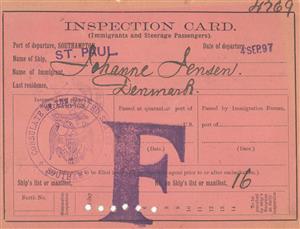Inspection Card
Brief Overview
Inspection card for steerage passengers.
1897 1999.073.007- Gift of Ron Thomas.
Share this Resource
Resource Categories
Primary SourcesIn the late 19th century, the U.S. government began to require more detailed information about prospective residents as well as a health inspection. After being checked against the ship's manifest, passengers were asked their name and country of origin, and questions such as whether they had ever been in prison, were an anarchist or bigamist, or if they had enough money to support themselves until they found a job. A wrong answer to any of the questions would mean that the immigrant might be detained for further questioning and possibly deported back to his/her country of origin. Women traveling alone were rarely deemed financially solvent, so were often detained until someone arrived to claim responsibility for them.
As more immigrants poured into the U.S., regulations were passed that included a health inspection to weed out those with "loathsome or infectious diseases."
Those who could not pass the inspection either were quarantined until they were healthy or had to return to their home country at the shipping company's
expense. To prevent unnecessary expenditures, the various lines gradually instituted health examinations at the ports of departure and healthy passengers
were given an inspection card such as this one from Southampton, England.
Unhealthy conditions in 3rd-class accommodations ("steerage") were often the direct cause of infectious disease in newly arrived immigrants. Eye infections
were particularly feared, as these did not present obvious symptoms. Inspectors used a button hook-like implement to turn back the eyelid in order
to check the inside surface. Occasionally only one member of a family would be deemed unfit for immigration, thus forcing the entire family to make
an unexpected and hard choice about its future.
